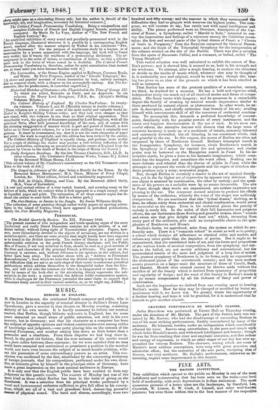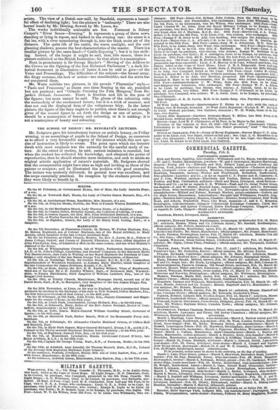FINE ARTS.
THE BRITISH INSTITUTION.
THE exhibition which opened to the public on Monday is one of the meet indifferent and uninteresting that has been seen on the walls—one level field of mediocrity, with more depressions in it than eminences. The more numerous pictures of a better class are the landscapes, by Stanfield, Leo, Creswick., W. Linton, E. W. Cook, J. Linnell, and other well-known painters; but even those seldom rise to the best manner of the respective artists. The view of a Dutch saw-mill, by Stanfield, represents a beauti- ful effect of declining light; but the picture is " teaboardy." There are also horses' heads by Mr. Herring, flowers by Mr. Lance, &c.
The works individually noticeable are few. Foremost is Sidney Cooper's "River Scene-Evening." It represents a group of three cows, standing or lying in repose, and bathed in the evening sun: the scene is a flat lea, with a river meandering through it, into the thick moist air of the distance. The quiet life of the cattle, the warm sunlight, and the cool glancing shadows, possess the best characteristics of the master. There is a smaller picture by the same hand-" Cattle Reposing "; but it is less strik- ing. Indeed, of the larger it might be said, that, this season, there is a picture exhibited at the British Institution; for that alone is a masterpiece.
Next in prominency is Sir George Haytees "Moving of the Address to the Crown on the Opening of the first Reformed Parliament "; a dark his- torical document in illustration-if lustre it can be said to give-of the Votes and Proceedings. The difficulties of the subject-the formal array, the dingy costume, the lack of action-are considerable; and the artist has not conquered them.
Mr. Watts exhibits two pictures, in his pseudo "Florentine' style,- " Paolo and Francesca," as Dante sees them floating in the air, punished but not penitent; and "Orlando Pursuing the Fate Morgans," from Bo- jardo's Orlando Inamorato. There is freedom and life in the pose of the figures; but more cannot be said. The gloom of the colouring suits the melancholy of the condemned lovers; but it is a trick of manner, and does not suit the displayed form of the voluptuous fairy. In the latter picture, the figure of the fairy ought to be perfect, since there is not enough given of the second figure to set forth the design as one of action. It should be a masterpiece of beauty and colouring, or it is nothing: it is not a masterpiece of beauty and colouring.



























 Previous page
Previous page